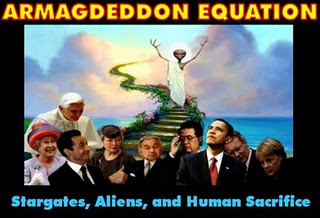New nuclear arms race: Kremlin challenges NATO encirclement
It is well known that Russia is annoyed by US led NATO encirclement policy threatening Russian borders. Unilateral policy being pursued by Washington for the last several years also causes concerns in Moscow.
With Russian President Vladimir Putin warning on June 19 Western countries against meddling in Moscow's affairs and that no one should speak to Russia through ultimatums, fears of a new nuclear arms race are being rekindled by the actions of arch rivals USA and Russia.
There are reasons to believe that Russia is angry with NATO’s attempt to contain Russia, the leader of former Soviet Union. In facing the containment policy of USA by using former Soviet republics, Vladimir Putin said on June 16 that Russia would add more than 40 new intercontinental ballistic missiles to its nuclear arsenal this year.
Putin made his announcement a day after Russian officials denounced a US plan to station tanks and heavy weapons in NATO states on Russia's border as the most aggressive act by Washington since the Cold War. Intercontinental ballistic missiles have a minimum range of more than 5,500 km (3,400 miles). Putin gave no more details of which missiles were being added to the nuclear arsenal. He has said several times that Russia must maintain its nuclear deterrence to counter what he sees as growing security threats, and Moscow reserves the right to deploy nuclear weapons in Crimea. Following annexation of Crimea, the West, led by the European Union and United States, has imposed punitive economic sanctions on Russia.
The Kremlin portrays spending on the Russian arms sector as a driver of economic growth, but Putin's critics say it is excessive and comes at the expense of social needs. "More than 40 new intercontinental ballistic missiles able to overcome even the most technically advanced anti-missile defence systems will be added to the make-up of the nuclear arsenal this year," Putin, flanked by army officers, said in a speech at an arms fair west of Moscow.
Such comments have helped whip up anti-Western sentiment in the former Soviet space and rally support behind Putin but have caused concern in the West, particularly countries on or near Russia's borders. Russian officials warned that Moscow would retaliate if the United States carried out its plan to store heavy military equipment in Eastern Europe, including in the Baltic States that were once in the Soviet Union. "The feeling is that our colleagues from NATO countries are pushing us into an arms race," RIA news agency quoted Deputy Defence Minister Anatoly Antonov as saying during "Army 2015", a fair at which arms and other military equipment are on show.
This Russian action would likely to increase alarm in the West. Tension has resurged between Russia and Western powers over Moscow's role in the Ukraine crisis, in which pro-Russian separatist forces have seized a large part of the country's eastern provinces after Russia annexed Crimea from Ukraine in early 2014.
Putin has however added Moscow will not be drawn into a new arms race although Russia is modernizing its armed forces. Putin said in his speech that 70 percent of the military equipment in use would by 2020 be the most up-to-date and top-quality. But lavish military spending is weighing heavily on Russia's national budget at a time when the economy is sliding towards recession, hit by low oil prices and Western sanctions.
With the USA and Russia in a state of renewed cold war for over a year now, it was inevitable that the nuclear arms race, far more important attribute of the first Cold War, would soon return with more force.
Russian president was speaking at an arms race fair and his plan for more than 40 new intercontinental ballistic missiles into service in 2015 as part of a wide-reaching program to modernize the military not a joke.
The move is in response to what Russia has slammed as an aggressive expansion of military presence in NATO states in Eastern Europe, which would provoke Russia to respond by stationing its army on its western borders. Stationing of heavy US military equipment in the Baltic States and Eastern Europe would amount to the most aggressive step by the Pentagon and NATO since the Cold War. Interfax news agency quoted a Russian Defense Ministry official General Yuri Yakubov as saying:"Russia would be left with no other option but to boost its troops and forces on the western flank."
The U.S. Navy is among those participating in a NATO landing exercise in Sweden. Around the same time, U.S. Secretary of the Air Force Deborah James announced that it could be sending some of its most advanced warplanes to Europe in a show of force. Already, the Pentagon has rotated B-2 and B-52 bombers, F-15Cs and A-10 attack planes as well as Army and Navy assets through Europe for exercises with allies under what's called Operation Atlantic Resolve. James said the F-22 Raptor, the Pentagon's premier fighter, could soon join them. This is all in addition to previous U.S. military actions in support of Ukraine and several Baltic countries, some of whom fear Russian President Putin -- either directly or indirectly -- will come after them next.
In reaction, Russia's foreign ministry on Monday accused NATO countries of "sliding into a new military confrontation with destructive consequences." That's not to say Moscow hasn't taken military action of its alone -- most conspicuously with its aircraft. The NATO late last year announced that it intercepted more than 400 Russian military planes in 2014 alone -- a 50% increase from the previous year. Then there was the Russian jet in May came within 10 feet of an American military plane in international airspace above the Black Sea. Putin upped the ante beyond provocative aerial maneuvers that same day, as he announced that he is buttressing his country's nuclear arsenal with an additional 40 intercontinental ballistic missiles.
USA and European leaders are already considering an additional round of sanctions they would impose on Moscow if it makes further military moves in Ukraine.
And since nuclear escalation usually takes place in a tit-for-tat mutual defection regime, earlier it was reported that the Americans are preparing a set of various measures, and among them the placement of heavy weaponry in Poland and other countries will be very important. And sure enough Russia, which it says is merely responding to NATO escalation, was promptly accused of escalating even more by the same NATO that keeps parking its own forces ever since the US-orchestrated Ukraine presidential coup was meant to convert Kiev into a potential NATO country and military base.
Nato and Western leaders accused Russia of sending soldiers and heavy weapons, including tanks and missiles, to the pro-Russian separatists in eastern Ukraine. Russia has repeatedly denied this, insisting that any Russians fighting there are "volunteers". Nato Secretary-General Jens Stoltenberg said that the statement from Putin was "confirming the pattern and behavior of Russia over a period of time; we have seen Russia is investing more in defense in general and in its nuclear capability in particular". He said: "This nuclear sabre-rattling of Russia is unjustified, it's destabilising and it's dangerous."
And just to stabilize things, NATO may well deploy some of its own tactical nukes in the region as a deterrence measure now that the second nuclear arms race is fully up and running. To be sure Stoltenberg essentially admitted that the next retaliation by NATO countries will also be a nuclear one: that "what NATO now does in the eastern part of the alliance is something that is proportionate, that is defensive and that is fully in line with our international commitments."
the BBC’s estimate of Russia's existing nuclear arsenal: Military stockpile of approximately 4,500 nuclear warheads; These include nearly 1,800 strategic warheads deployed on missiles and at bomber bases; Another 700 strategic warheads are in storage along with roughly 2,700 non-strategic warheads; A large number - perhaps 3,500 - of retired, but still largely intact warheads await dismantlement.
Back in December 2013 Russia stationed nuclear-capable Iskander (ss-26) missile launchers, as one of the first nuclear moves in the current Cold War 2.0 arms race, along the polish border to deter the US missile defense system in Poland. As such, all that the current second nuclear arms race needs is a spark. Incidentally, back in 1937 a comparable Fed rate hike such to the one the Fed is currently contemplating, led to a 50% crash in the stock market. More importantly, less than two years later, World War II broke out. On the day after the crash, investigators said they had reviewed the flight recorders, and confirmed that there were no technical problems with the Soviet-built aeroplane, ruling out initial theories that the 20-year-old aircraft was at fault. The Russian maker of the Buk air defence missile system says it has concluded that Malaysian Airlines flight 17 was downed by an older version of the missile. It says the type is not in service with the Russian military but is in Ukrainian arsenals.
The war of words between America and Russia is escalating. So, too, is the movement of implements of war -- from US fighter jets to Russian nuclear weapons. the rhetoric and actions from both sides have definitely ratcheted up in recent days, raising concerns of a new arms race -- if not worse -- amid tensions both sides blame on each other. The major players all claim their movements are defensive and necessary responses to their foe's provocation. None has talked of an invasion.
Nearly every American and European attempt at deterring Putin has instead triggered an opposite reaction: more military exercises, more provocative behavior and a persistent refusal to back down in the face of Western demands.
US and Russian nuclear arsenals as of April 2010 |
|||||||||||||||||||||||||||||||||||||||||||||||||||||||||||||||||||||||||||||||||||||||||||||||||||||||||||||||||||||||||||||||||||||||||||||||||||||||||||||||||||||||||||||||||||||||||||||||||||||||||||||||||||||||||||||||||||||||||||||||||||||||||||||||
|
US President Barack Obama and his Russian counterpart, Dmitry Medvedev, signed a landmark nuclear arms treaty in the Czech capital, Prague in April 2010. The treaty commits the former Cold War enemies to each reduce the number of deployed strategic warheads to 1,550 - 30% lower than the previous ceiling. Here is a breakdown of their respective arsenals.
Note: The data for the US relates to 2009. That for Russia, 2010. |
|||||||||||||||||||||||||||||||||||||||||||||||||||||||||||||||||||||||||||||||||||||||||||||||||||||||||||||||||||||||||||||||||||||||||||||||||||||||||||||||||||||||||||||||||||||||||||||||||||||||||||||||||||||||||||||||||||||||||||||||||||||||||||||||
Former ideological super power rivals USA and Russia with huge piles of arms arsenals do not seem to enforce nuclear disarmament globally. The US vested interests in maintaining upper hand in arms arsenals, especially WMD has emboldened Russia to ignore global nuclear disarmament and go slow in the hopeless arms reduction talks.
NATO encirclement!
Comments
There are 0 comments on this post













